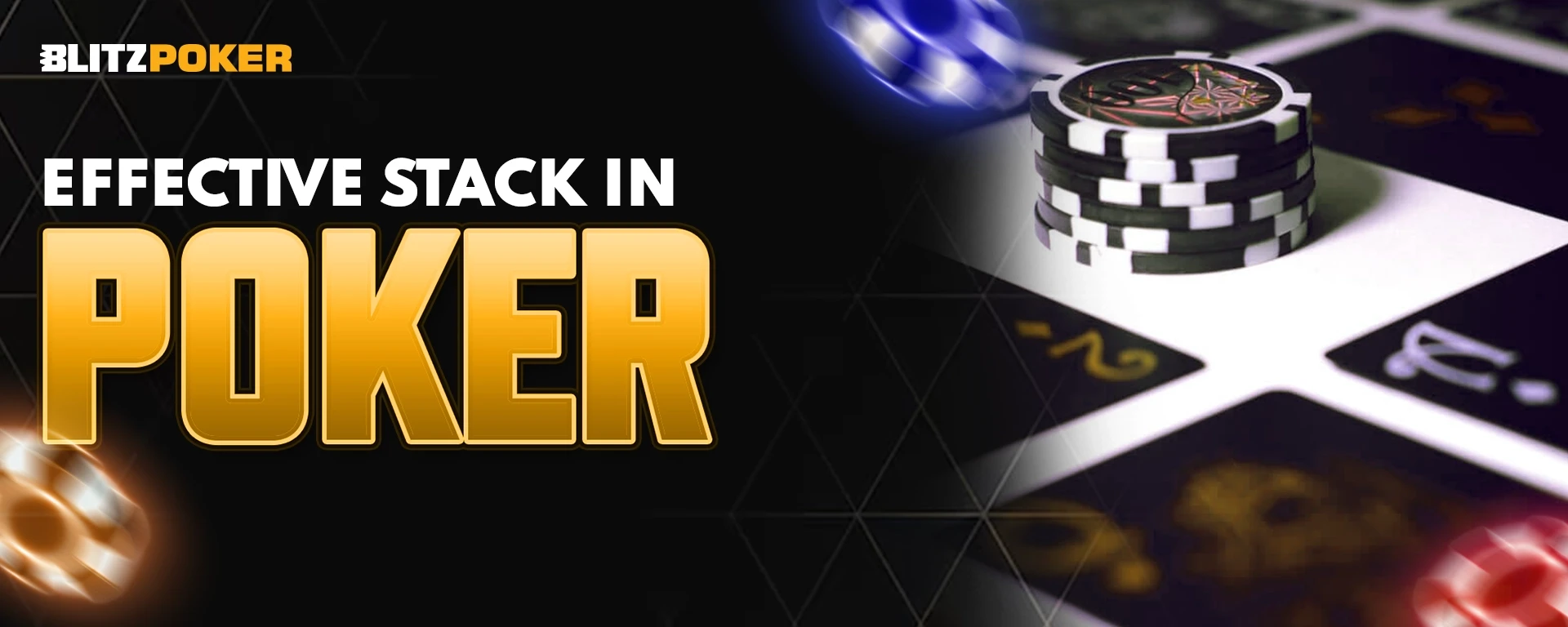Effective Stack in Poker
In poker, it’s important to understand stack sizes to play strategically. One crucial idea is the “effective stack,” which is just the smallest stack size among the players in a hand. This matters because it determines the maximum amount anyone can risk if they decide to go all-in. By paying attention to the effective stack, players can make smarter choices and get a better sense of how things might unfold in the hand. Unleash the ultimate poker experience with BLITZPOKER, where every hand keeps you on the edge of your seat!
Meaning Of Effective Stack in Poker
In poker, the term “effective stack” refers to the smallest stack size in play among the players involved in a hand. It essentially determines the maximum amount that can be wagered by any player in a hand when they go all-in.
Effective Stack in Poker Example
Imagine you have a stack of ₹1,50,000 and your opponent has ₹41,250. The effective stack between you is ₹41,250. Even though you have more chips, the most you can play for in this hand is ₹41,250, which is your opponent’s stack.
Now, let’s consider another example. Suppose you’re at a 4-handed table and have 90 big blinds (bb) in your stack. The other players have the following stacks:
- Player 1 (Arjun): 25bb
- Player 2 (Maya): 90bb
- Player 3 (Rahul): 110bb
Your effective stack size will change based on which player you’re up against:
- Against Arjun, the effective stack is 25bb.
- Against Maya, it’s 90bb.
- Against Rahul, it’s also 90bb because your stack is smaller.
How Effective Stack Influences Strategy?
In poker, the concept of “effective stack” really influences how you play your strategy. It’s all about the smallest stack size between you and your opponent in a hand. Here’s why it’s important:
Bet Sizing and Pot Control: When the effective stack is small, your bets usually need to be smaller too. This changes how you try to control the pot across different stages of a hand. You might find yourself going all-in more often with smaller stacks because there aren’t as many chips left to negotiate with.
Hand Selection: If the stacks are short, you will likely be more aggressive with a wider range of hands, especially in tournaments where blinds keep increasing. Larger stacks allow you to play more post-flop, but playing speculative hands becomes risky because more chips are at stake.
Risk vs. Reward: Knowing your effective stack helps you weigh your risks and rewards better. Small stacks mean each decision is more crucial since you could end up putting a lot of chips in play or going all-in.
Implied Odds: This concept refers to the potential payoff if your hand hits. With bigger stacks, you generally get better implied odds, meaning it might be worth playing hands that could win you a big pot.
Fold Equity: Your ability to make your opponents fold changes with stack sizes. Bigger stacks make opponents more comfortable calling bigger bets, reducing how often they might fold to you. Small stacks can give you more leverage to make opponents fold since calling would put them at significant risk.
Opponent Pressure: If you have a bigger stack than your opponents, this gives you a chance to put pressure on them — forcing them into tough decisions where they have to risk their tournament life or a large chunk of their chips.
Odds and Effective Stacks
The effective stack size is crucial because it tells you the most you can potentially win in a single hand. This concept is key when you’re figuring out the odds or probability of winning that hand. If the effective stack is large compared to the current bets, you might consider playing hands that are on the edge, like suited connectors or low pocket pairs. Even though these hands don’t have the best odds of winning, the chance to win your opponent’s entire stack makes it worthwhile to call a preflop bet with them.
How Effective Stack Sizes Shape Your Game
Cash Games
In cash games, you often sit at the table with deeper stacks, which opens up a world of possibilities for strategic play. With more chips in relation to the blinds, you can afford to take chances on speculative hands like suited connectors and small pairs. This approach can pay off big if you hit the right flop.
Here, it’s all about those implied odds—the potential wins down the line if you catch that perfect card. Deep stacks also let you ramp up the aggression with bluffs, as you’ve got enough room to manoeuvre without putting your entire stack on the line.
Tournaments
Tournament play is a whole different ball game because your effective stack size constantly changes as the blinds increase. In the early stages, you might play it cool and pick your spots carefully. But as the tournament progresses and stacks get shorter, it’s time to shift gears. Aggression becomes your friend, especially when you’re grinding for chips or leveraging the fold equity.
With the tournament payouts at stake, effective stack sizes come into play with the Independent Chip Model (ICM), especially near the bubble or final table. Here, your strategy might shift considerably to ensure you hang in there for a payout.
Sit & Go’s
In Sit & Go’s, you start with relatively deep stacks, similar to a cash game, so you can play more hands and employ some post-flop tactics early on. But watch out—it’s a fast-paced format. Before you know it, the blinds have increased, and those stacks don’t look as deep anymore.
As the game progresses, you’ll need to think about push/fold strategies. This is crucial when the blinds start eating into the stacks quickly. And let’s not forget the pressure cooker that is the bubble stage. Players short on stacks might tighten up, waiting for others to bust, while those with bigger stacks can exploit this by applying pressure.
